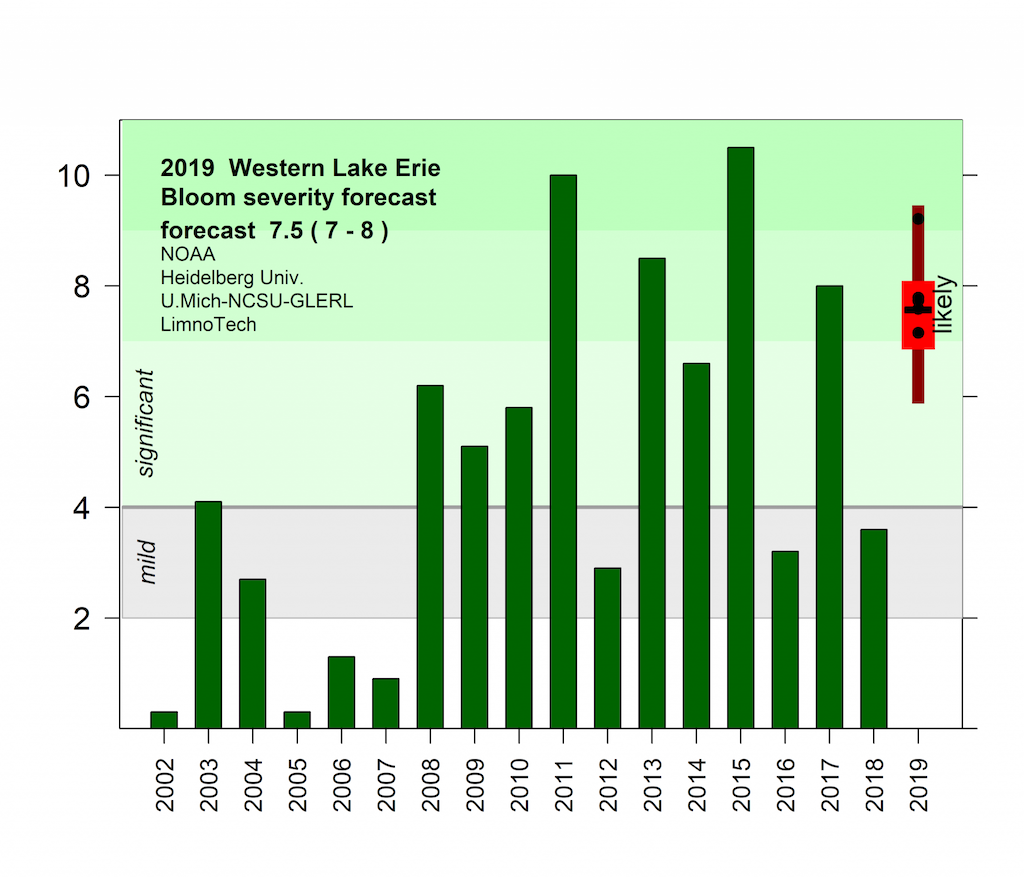PUT-IN-BAY, Ohio — The National Oceanic and Atmospheric Administration researchers predict a harmful algal bloom in Lake Erie measuring 7.5 on the severity index, which could be significantly more severe than last year.
Anything over 5 is considered critical. The index is based on the amount of algae measured in a bloom over a sustained period. NOAA made the announcement July 11.
This year’s prediction could range between 6 and 9 on the index, which is a scale of 1-10, with 10 being the most severe. Last year’s bloom had a severity of 3.6 — but was expected to be a 6.
Researchers reported a decrease in phosphorous though, which could mean improvements may be made faster than expected.
Last year’s forecast was not as accurate as they had hoped, said Rick Stumpf, oceanographer for NOAA’s National Centers for Coastal Ocean Science. Researchers made adjustments to their models this year.

Good news
Researchers noted a 30% decrease in dissolved reactive phosphorus in the lake this year. Harmful algal blooms are caused largely by nutrient runoff, especially phosphorus.
With the extreme rainfall Ohio has seen this year, this decrease was unexpected. Laura Johnson, director of NOAA’s National Centers for Coastal Ocean Science, said it may be due to rainfall preventing farmers from planting and fertilizing their fields last fall and this spring.
Johnson said the significant decrease in this season alone “means improvement can be made much quicker than we might have expected.”
When farmers fertilize their fields, they add to the phosphorus on the surface soil, which can be two or three times higher than the bottom of the soil, Johnson said. Applying fertilizer under the surface, as opposed to on the surface, may help reduce future runoff.
“If it’s a placement issue, then that means we can fix it,” Johnson said, noting the importance of getting technology for subsurface placement to farmers.
Farmers
“I think our farmers have really recognized that they want to be part of the solution,” said Yvonne Lesicko, Ohio Farm Bureau’s vice president of public policy. She noted many farmers in the Western Lake Erie basin have decreased their fertilizer use and experimented with new practices.
One of the difficulties is that different practices work for different fields. The Ohio Farm Bureau partners with the U.S. Department of Agriculture Natural Resources Conservation Services on several demonstration farms that study the return and viability of different practices for different farms.
While subsurface application can be expensive, Lesicko said knowing it is significant may help groups focus more research and dollars towards this area.
Farmers can continue to prevent nutrient runoff from their fields this year by planting cover crops on their unplanted acres.
Water quality
The algal blooms are capable of producing toxins that threaten Lake Erie water quality, but not all will produce those toxins. The size of the bloom does not indicate toxicity.
Some local cities may need to treat their drinking water to keep it safe, and parts of the lake may not be suitable for recreation. The bloom also brings risks for wildlife health.
NOAA is still developing ways to measure and predict bloom toxicity.
The bloom will not necessarily affect all parts of the lake equally. The winds this summer will concentrate or dissipate the bloom in different areas of the lake.

Last year’s forecast
High winds in September 2018, rapid warming and an early bloom end may have contributed to the inaccuracy of last year’s forecast.
This year, scientists replaced one of the models they used and excluded another based on weather conditions. They also changed how the different models they used were weighted based on last year and the conditions this year.
“I am confident that the forecast this year is better than last year,” Stumpf said.










